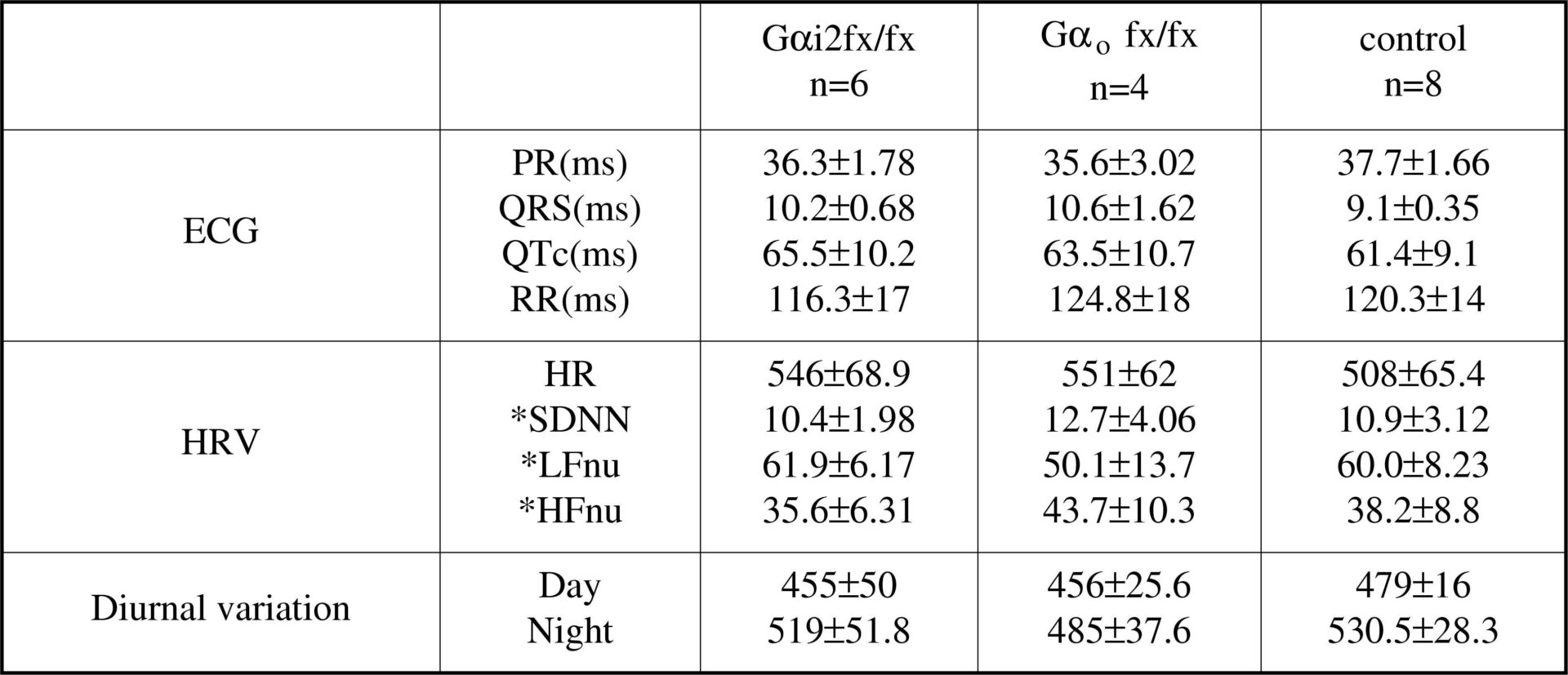Muscarinic receptor mediated cardiac parasympathetic activity is essential for regulating heart rate. Multiple isoforms of Gα subunits (Gαi 1, 2, 3 as well as Gαo) are present within the heart and their role in modulating electrical activity remains unresolved. We have studied mice with global genetic deletion of Gαi2, Gαo and combined deletion of Gαi1 and Gαi3 and found that there is a selective defect of parasympathetic heart rate modulation in mice with Gαi2 deletion (Zuberi et al., 2008). More specifically these mice have elevated heart rates, loss of Heart Rate Variabilty (HRV) comparable to that after application of atropine and tertiapin Q and attenuation of heart rate slowing after application of carbachol. Gαo knock outs were tachycardic and Gαi1 and Gαi3 do not appear essential for parasympathetic responses in-vivo. We thus investigated cardiac specific deletion of Gαi2 and Gαo using the Cre-LoxP system (Agah et al., 1997). C57/bl mice expressing cre under the α-myosin heavy chain promoter were crossed with 129sv mice engineered with loxp sites allowing deletion of exons 2, 3 and 4 in Gαi2 and exons 5 and 6 in Gαo. Male heterozygotes (Gαi2flx/wt and Gαoflx/wt) containing α-MHC cre were then crossed with female Gαi2flx/wt and Gαoflx/wt to obtain Gαi2flx/flxα-MHCcre and Gαoflx/flxα-MHCcre mice, and all other genetic combinations were used as control. The cardiac specific deletion was confirmed by genomic PCR and real-time RT PCR analysis. We then compared groups of mice with cardiac specific deletion of Gαi2 (n=6) and Gαo(n=4) against littermate controls (n=8) using ECG telemetry. Tunnelled electrodes secured in a lead II configuration were implanted intra-abdominally using 1% isoflurane as an inhalational anaesthetic. In contrast to our findings with global knock outs, cardiac specific deletion of either Gαi2 or Gαo didn’t show any difference in the parameters such as ECG, HRV or diurnal variation in heart rate when compared with their littermate controls using nonparametric one way ANOVA (Data shown in the table).Our findings suggest that some of the phenotype observed in the global knockouts may result from abnormal control of heart rate dynamics through central or peripheral nervous pathways.
University of Manchester (2010) Proc Physiol Soc 19, C51
Oral Communications: The effects of cardiac specific deletion of G??i2 and G??o on heart rate dynamics
S. Sebastian1, Z. Zuberi1, L. Birnbaumer2, A. Tinker1
1. Division of Medicine, University College London, London, United Kingdom. 2. National Institute of Health Sciences, North Carolina, North Carolina, United States.
View other abstracts by:
Parameters of ECG and Heart Rate Variabilty<#13>All values are expressed as means&#177;SD.<#13>*SDNN SD of Mean RR interval<#13>*LFnu Normalised low frequency band<#13>*HFnu Normalised high frquency band
Where applicable, experiments conform with Society ethical requirements.

